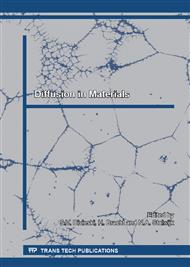p.68
p.79
p.85
p.91
p.101
p.106
p.112
p.120
p.127
Theoretical Evaluation of Anisotropic Distortion Associated with Point Defects in Ordered Compounds
Abstract:
To verify the assumption that the anelastic relaxation effect observed in Ni3Al is due to stress-induced reorientation of antisite Al atoms [Numakura and Nishi, Mater. Sci. Eng. A 442 (2006) 59-62], the magnitudes of the anisotropic distortion produced by the intrinsic point defects have been evaluated by ab initio calculations. The anisotropy of the λ tensor (the strain per unit concentration of a particular defect) for the two candidate defect species, namely a Ni vacancy and an antisite Al atom, has been computed by full structure optimization of a supercell containing a single point defect: the difference in the principal values is +0.46 and −1.12, respectively. The relaxation strength estimated for antisite Al atoms agrees fairly well with experiment, while that for Ni vacancies is far too small because of their much lower concentration. The relaxation is, therefore, conclusively attributed to antisite Al atoms.
Info:
Periodical:
Pages:
101-105
Citation:
Online since:
May 2015
Authors:
Price:
Сopyright:
© 2015 Trans Tech Publications Ltd. All Rights Reserved
Share:
Citation:


